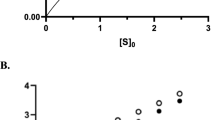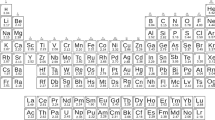Abstract
IN contemporary kinetic studies, the values of rate constants are often expressed by means of activation parameters, either by the activation energy E* and the præ-exponential factor A, or by the activation enthalpy ΔH≠ and entropy ΔS≠. For further discussions in terms of substituent or solvent effects and similar theories of organic chemistry, many authors1 prefer the free activation energy ΔG≠ (that is, the logarithm of the rate constant) at an arbitrary temperature before the activation energy E* or enthalpy ΔH≠. If the results of such discussions have to be independent of the arbitrary temperature, a functional dependence must exist between the activation parameters in a series of related reactions. This dependence is also the necessary condition2 for the validity of various linear free-energy relationships (for example, Hammett equation) at different temperatures. In fact, linear relationships obtained by plotting E* versus log A or ΔH≠ versus ΔH≠ have been described many times2–6. They are referred to as the isokinetic relationship2 or the compensation law4 (equations 1a and b). The proportionality factor β, called the isokinetic temperature, has been also discussed theoretically2,5: 
This is a preview of subscription content, access via your institution
Access options
Subscribe to this journal
Receive 51 print issues and online access
$199.00 per year
only $3.90 per issue
Buy this article
- Purchase on Springer Link
- Instant access to full article PDF
Prices may be subject to local taxes which are calculated during checkout
Similar content being viewed by others
References
Evans, M. G., and Polanyi, M., Trans. Farad. Soc., 32, 1333 (1936). Ingold, C. K., Structure and Mechanism in Organic Chemistry (Cornell University Press, New York, 1953).
Leffler, J. E., J. Chem. Phys., 23, 2199 (1955); J. Org. Chem., 20, 1202 (1955).
Fairclough, R. A., and Hinshelwood, C. N., J. Chem. Soc., 538, 1573 (1937).
Blackadder, D. A., and Hinshelwood, C., J. Chem. Soc., 2720, 2728 (1958).
Brown, R. F., and Newsom, H. C., J. Org. Chem., 27, 3010 (1962). Brown, R. F., J. Org. Chem., 27, 3015 (1962).
Laidler, K. J., Trans. Farad. Soc., 55, 1725 (1959).
Petersen, R. C., Markgraf, J. H., and Ross, S. D., J. Amer. Chem. Soc., 83, 3819 (1961).
Exner, O., Coll. Czech. Chem. Commun. (in the press).
Craft, M. J., and Lester, C. T., J. Amer. Chem. Soc., 73, 1127 (1951).
Author information
Authors and Affiliations
Rights and permissions
About this article
Cite this article
EXNER, O. Concerning the Isokinetic Relationship. Nature 201, 488–490 (1964). https://doi.org/10.1038/201488b0
Issue Date:
DOI: https://doi.org/10.1038/201488b0
This article is cited by
-
Kinetics and Mechanism of the Oxidation of 4-Oxo-4-arylbutanoic Acids by N-bromophthalimide in Aqueous Acetic Acid Medium
Journal of Solution Chemistry (2013)
-
Thermodynamics of complexation of tauro- and glyco-conjugated bile salts with two modified β-cyclodextrins
Journal of Inclusion Phenomena and Macrocyclic Chemistry (2011)
-
Oxidation of benzhydrol by tributylammonium chlorochromate: a kinetic and mechanistic study
Reaction Kinetics, Mechanisms and Catalysis (2010)
-
Kinetics and Mechanism of the Oxidation of Propan-1-ol and Propan-2-ol by Permanganate in the Absence and Presence of Tween-20 in Perchloric Acid Medium
Transition Metal Chemistry (2005)
-
Kinetic Regularities of Reactions of O,O-Diaryl Phosphorohydrazidothioates with Phenyl Isothiocyanate in Benzene
Russian Journal of General Chemistry (2005)
Comments
By submitting a comment you agree to abide by our Terms and Community Guidelines. If you find something abusive or that does not comply with our terms or guidelines please flag it as inappropriate.



